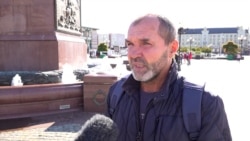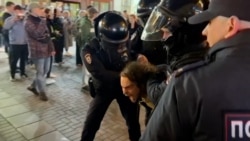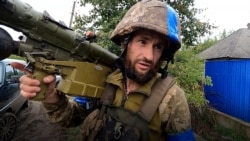The Kremlin’s aim to mobilize up to 300,000 men to fight in Ukraine faces significant obstacles and -- even if achieved -- may not prevent Russia from losing more ground or losing the war, analysts said.
Russian President Vladimir Putin announced the “partial mobilization,” due to start immediately, in an address broadcast to the nation on September 21, nearly eight months after he launched a large-scale invasion that he apparently believed would bring Kyiv to its knees within a few days.
Instead, the call-up effort comes as Ukrainian forces push ahead with a counteroffensive in the east that has laid bare Russia’s lack of manpower and other military shortcomings along a front that extends hundreds of kilometers.
Mobilization “may extend the Russian ability to sort of sustain this war but does not change the overall trajectory and outcome,” Michael Kofman, a military analyst and head the Russia Studies Program at the U.S.-based think tank CNA, said in an online discussion on September 21.
Rob Lee, a military expert and senior fellow at the U.S.-based Foreign Policy Research Institute’s Eurasia Program, said that the mobilization might solve the manpower problem “for a few months” but that it is not a long-term solution.
“I still think Ukraine has a lot of advantages going forward,” he said.
WATCH: Long lines of vehicles have formed at a border crossing between Russia's North Ossetia region and Georgia after Moscow announced a partial military mobilization.
Putin said the “partial mobilization” would be limited to members of the military reserves, especially those who have combat experience or special skill sets.
In an interview later on September 21, Russian Defense Minister Sergei Shoigu said the military would seek to conscript up to 300,000 reservists in phases.
Members of Russia’s military reserves began receiving notices on September 20 to appear for two-week training sessions starting later this month.
‘A Notional Figure’
Analysts immediately cast doubt on Russia’s ability to conscript, train, feed, and equip such a large force anytime soon.
Mark Hertling, the former commander of U.S. Army forces in Europe, said in a tweet that it would be “extremely difficult” to mobilize 300,000 people, while Kofman dismissed it as a “notional figure.”
Dara Massicot, a military analyst at the RAND Corporation, a Washington-based think tank, said the Russian Defense Ministry had let its mobilization system “fall apart” for years because it did not expect to fight a large-scale land war again.
“They will not be able to do this [mobilization] well. The system structurally cannot” handle it, she said in a tweet.
Russia has more than 2 million former conscripts and contract servicemen in reserve “on paper,” according to the Institute for the Study of War.
However, it said that few of them are actively trained or prepared for war. In the United States, members of the military reserves must take part in monthly drills and a two-week annual training.
Meanwhile, Kofman said there is a natural limit to how many soldiers Russia can deploy to Ukraine at any one time.
“No matter how many personnel they mobilize -- whatever number you may imagine it to be -- the Russian military is actually quite constrained in the number of troops it can sustain and command in the theater of military operations,” Kofman said.
Botched Invasion
Putin ordered some of Russia's best forces to invade Ukraine on February 24 under the apparent assumption they would be greeted as liberators – one of several deeply misguided expectations that stemmed from bad intelligence and other factors.
Ukrainian forces put up fierce resistance, inflicting serious losses on Russia’s military. In early August, before Ukraine’s counteroffensive in the east, a Pentagon official estimated that 70,000 to 80,000 Russian soldiers had been killed or wounded.
Russia tried to raise fresh forces this summer by offering volunteers who agreed to sign short-term contracts monthly salaries far above the national average.
The campaign failed to attract a significant number of volunteers, demonstrating the lack of interest among Russians in fighting in Ukraine, and -- following Kyiv’s advances this month -- prompting Putin to launch a mobilization drive, albeit labeled a partial one, after months of hesitancy driven by political concerns.
While the state has tightened the screws on dissent for years and clamped down even harder since the invasion, Russians in Moscow, St. Petersburg, Yekaterinburg, and other cities protested in the streets following Putin’s announcement, some urging him to go fight himself. More than 1,300 people were detained.
Many young Russians have left the country since the invasion and more sought to get out on September 21, with plane ticket prices soaring as demand increased.
“Thousands of Russian men -- our fathers, brothers and husbands -- will be thrown into the meat grinder of the war,” said Vesna, an Russian opposition movement that called for protests. “What will they be dying for? What will mothers and children be crying for?”
Low Morale
While mobilization could help address Russia’s manpower problem in the coming months, its military also suffers from a lack of professional soldiers, leaders, and trainers, as well as low morale, experts said.
“When we talk about manpower, it's not just quantity that is important. It's about how well trained are these soldiers, how much unit cohesion do they have, what is the morale -- all these kinds of intangible things factor into how useful units are,” Lee said.
“This war is going to be increasingly fought by volunteers on the Ukrainian side who are motivated and who have morale. On the Russian side we are going to see a larger and larger share of people who don’t want to be there,” he said.
Ukrainian conscripts and volunteers are undergoing more professional training by British forces and “that is only going to become more important over time,” he said.
Many Russian officers who train reservists were sent to the front earlier this year as replacements or to lead additional forces, raising questions about who will prepare and lead the newly mobilized men, analysts said.
Massicot said it could take Russia’s military “months to a year” to create a well-trained armored unit that stands a chance in the largest war in Europe since World War II.
Russia rushed the newly created 3rd Army Corps into Kharkiv region in late August after about a month of training. It was quickly routed by Ukrainian forces.
Experts said Russia is likely to send the first group of recruits to the front lines, where some of its fighting units are at half capacity.
'Only The Beginning'
Lee said former conscripts who have been out of the force for years are not going to be in a position to do much after two weeks of training if they do not already have advanced skills.
“Sitting in a trench and shooting at someone? They can do that. But having them do offensive operations? They are going to struggle,” he said.
With Putin’s hold on power at stake in this war and Ukraine seeming to hold the momentum at this stage, Putin may not stick to the stated limits of the current “partial” mobilization, analysts said.
One section of Putin’s mobilization decree was withheld from the public, adding to suspicions that the effort could be broadened at any time.
“This mobilization phase may just be the beginning of more mobilization,” Kofman said. “Everybody in Russia understands they could be in the next wave, and that this is only the beginning.”
















